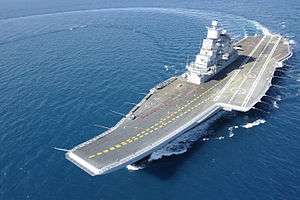Soviet aircraft carrier Admiral Gorshkov
Admiral Gorshkov was an aircraft carrier (heavy aircraft cruiser in Russian classification)[2] of the Soviet Navy and the Russian Navy from 1987 to 1996. The ship's original name was Baku when she was commissioned in 1987. Sometimes Admiral Gorshkov is considered a separate class due to her improvements including a phased array radar, extensive electronic warfare installations, and an enlarged command and control suite. She was launched in 1982, and was in service from 1987 to 1991 in the Soviet Navy as Baku, and from 1991 to 1996 in the Russian Navy as Admiral Gorshkov. In 2004, she was sold to India and converted into a STOBAR carrier now named INS Vikramaditya.
 | |
| History | |
|---|---|
| Name: | Admiral Gorshkov |
| Namesake: | Sergey Gorshkov |
| Builder: | Chernomorskiy Yard, Nikolayev |
| Laid down: | 17 February 1978 [1] |
| Launched: | 1 April 1982 [1] |
| Commissioned: | 11 December 1987 [1] |
| Decommissioned: | 1996 |
| Fate: | Sold to India on 20 January 2004 |
| General characteristics | |
| Class and type: | Kiev-class aircraft cruiser |
| Displacement: | |
| Length: | 273 m (896 ft)[1] |
| Beam: | |
| Draught: | 9.42 m (30.9 ft)[1] |
| Propulsion: | 4 shaft geared steam turbines, 200,000 shp |
| Speed: | 32 kn (59 km/h; 37 mph) |
| Endurance: | 13,500 nmi (25,000 km; 15,500 mi) at 18 kn (33 km/h; 21 mph) |
| Armament: | 6 × twin SS-N-12 Sandbox SSM launchers (12 missiles), 24 × 8-cell SA-N-9 vertical SAM launchers (192 missiles), 2 × 100 mm guns, 8 × AK-630 30 mm CIWS, 10 × 533 mm torpedo tubes, 2 × RBU-6000 anti-submarine rocket launchers |
| Aircraft carried: | |
History
The ship was laid down in 1978 at Nikolayev South (Shipyard No.444) in Ukraine, launched in 1982, and commissioned in December 1987. The delay in commissioning was largely caused by software bugs in the new command and control system. The ship was renamed Admiral Gorshkov after the collapse of the Soviet Union in 1991, as the city of Baku was now in independent Azerbaijan. Sergey Gorshkov was responsible for the expansion of the Soviet Navy during the Cold War.
In 1994, following a boiler room explosion, the ship was docked for a year of repairs. Although she returned to service in 1995, she was finally withdrawn in 1996 and offered for sale.

On 20 January 2004, Russia agreed to sell Admiral Gorshkov to India after an extensive upgrade at Sevmash Enterprise.[3][4] In December 2009, it was reported that India had agreed to pay a price of US$2.3 billion.[5][6][7] The carrier, now christened INS Vikramaditya, was commissioned into the Indian Navy on 16 November 2013.[8]
Design
The fourth of the Project 1143 aircraft carrying cruisers, Baku had many differences from the rest of the class, trialing technologies to be used on the Admiral Kuznetsov. The most obvious is the massive passive electronically scanned array above the bridge. This was the phased array antenna for the Mars-Passat ("Sky Watch") 3D air search radar, comparable to the US SCANFAR radar. Like SCANFAR, Sky Watch proved troublesome and was probably never operational.[10]
The biggest change to the weapon systems was the replacement of the SA-N-3 'Goblet' and SA-N-4 'Gecko' SAM launchers with four SA-N-9 'Gauntlet' VLS launchers. This allowed room for another two SS-N-12 'Sandbox' launchers. The two AA guns of the Kievs were replaced with 100 mm guns, and the SUW-N-1 launcher was removed.
The air wing was the same as the other Kievs, consisting of a squadron of twelve Yak-38 'Forger' V/STOL aircraft (until they were retired in 1992), twelve Ka-27 'Helix-A' ASW/SAR helicopters and two Ka-31 'Helix' AEW helicopters. Flight operations were assisted by the distinctive new Cake Stand TACAN.
Baku was used for trials of the Yak-141 Freestyle supersonic VTOL fighter.

References
- "Project 11434". Archived from the original on 2013-04-04. Retrieved 2013-01-29.
- Due to restrictions imposed by the Montreux Convention limiting the tonnage of aircraft carriers traveling through the Bosporus, all Soviet and Russian aircraft carriers are named as aircraft carrying cruisers. In the case of Admiral Gorshkov, this accurately reflects the ship's mission and weapons fit.
- "INS Vikramaditya: Waiting for Gorshkov". Defense Industry Daily. 2012-12-24. Retrieved 2013-02-02.
- 09.07.2009 (9 July 2009). "Russia's Admiral Gorshkov aircraft carrier to become expensive Mercedes for Indian navy". Pravda English. Retrieved 2013-02-02.CS1 maint: numeric names: authors list (link)
- PTI (2009-12-08). "India, Russia end stalemate over Gorshkov price deal". Times of India. Retrieved 2013-02-02.
- "India, Russia end stalemate over Gorshkov's price deal". Indian Express. 2009-12-08. Retrieved 2013-02-02.
- "Archived copy". Archived from the original on 2011-06-06. Retrieved 2009-12-17.CS1 maint: archived copy as title (link)
- "INS Vikramaditya, India's biggest warship, finally arrives". ndtv.com. Retrieved 2017-12-17.
- http://www.harpoonhq.com/waypoint/articles/Article_044.pdf
- Dranidis, Dimitris (February 2003). "Shipboard Phased Array Radars: Requirements, technology and operational systems" (PDF). warfaresims.com. Waypoint. Retrieved 2016-03-17.
External links
| Wikimedia Commons has media related to Admiral Gorshkov (ship, 1982). |